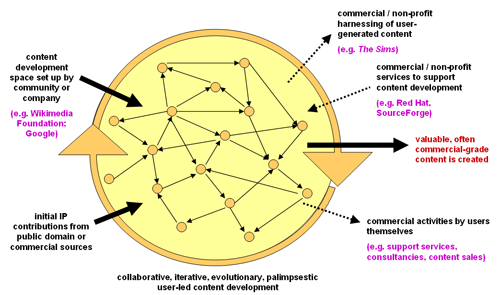The capability to create and share art practises on the internet has allowed creative talent to prosper in the online setting. Artists are now able to share their work with an international audience which would not have been capable before. Abilities which would have failed to gain interest before are now found anew through the communities which gather around these interests. Online artists in particular now have the ability to collaborate with others more regularly then they were previously able to because of the convenient nature of the internet. Other projects have taken this to another level in creating wide community led collaborations in the name of art.
A community which is built upon large artistic collaborations is
SITO and their synergy projects. SITO has
11 projects in all which encourage artists to contribute to the overall outcome of an artistic result, some of which are continually being worked on despite their long running period. It’s interesting to note that this art community began during the 90s, the oldest projects beginning around 1993, showing that artistic collaboration online is not a new movement.

One of the initial projects that later evolved into their latest collaborative works was
Grid. These first works were pieced together while communicating over
IRC and email to reach the final art piece. To begin, an artist provided a small square image which was placed within the centre of the work. Other artists then built upon the original image by submitting their own works to be placedon the sides, having them blend in to give a flow across the various images. The final result were collaborative works displaying the different techniques of the various contributors while also producing a collaborative style which can be found in the projects following the first collaboration.
Another project running is the
HyGrid, which works in a very similar fashion to the original Grids. A user submits the “seed” image before other participants reserve spaces surrounding it to upload their own images which assemble depending on the content of the original square. The main difference between these and Grid are that there is a more rapid response to reserving and submitting images due to greater advances in internet technology.Previously, this would’ve proven difficult when only using email and IRC, as well as being closed off from others who may have wished to join in the activity.
The most popular of the projects on the SITO site is
Gridcosm. Working with the idea of HyGrid; Gridcosm takes this to another level in collaborative projects by being constructed with multiple levels of graphical squares which are continually built upon. A level consists of 9 squares, with the centre being the “seed” image that others build off. Once all squares are completed, that work then becomes the centre piece for the next level and the process is repeated. There are currently 3042 levels (and counting) in Gridcosm and from
statistics shown, continues to have images regularly uploaded to the site to the complete the current level. Other projects that SITO offers are
Slithr, an animation project,
Impulse Freak, a collaborative comic book and
Shuffleupagus, an offline game created for players to produce a 9 page comic through various collaborative activities.
All of the projects offered at SITO permit any member to contribute to the community with no restrictions on the content they provide. Working together, each contribution builds the art pieces, whether they come to finished works (like the original Grids) or are continually evolving (like Gridcosm). Works like these will hopefully continue to be founded, not just in art communities but in other areas of interest. These collaborative efforts demonstrate the possibilities that were previously hindered before the use of the internet and show the opportunities that online communities are open to.









